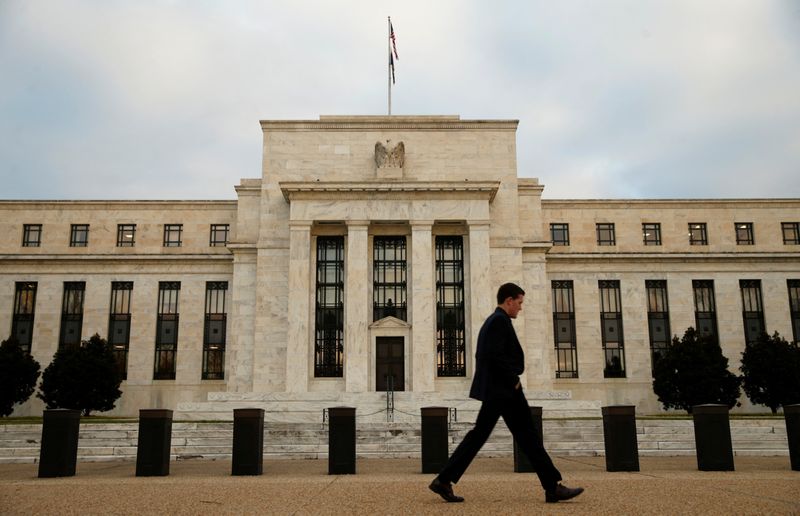By Pete Schroeder
WASHINGTON (Reuters) -Big U.S. banks sailed through the Federal Reserve's annual health check on Wednesday, in a vote of confidence for a sector still recovering from turmoil earlier this year and facing an uncertain economic outlook.
The Fed's "stress test" exercise showed lenders, including JPMorgan Chase (NYSE:JPM), Bank of America (NYSE:BAC), Citigroup (NYSE:C), Wells Fargo (NYSE:WFC), Morgan Stanley (NYSE:MS) and Goldman Sachs (NYSE:GS), have enough capital to weather a severe economic slump, paving the way for them to issue share buybacks and dividends.
The 23 banks tested, which have more than $100 billion in assets each, would suffer a combined $541 billion in losses under the Fed's severe downturn scenario - one of its toughest yet - but would still have over twice the amount of capital required.
While the results look strong, and were celebrated by the industry, critics warned they paint an overly optimistic picture just months after the government was forced to intervene to protect depositors.
Among the top performers were Charles Schwab (NYSE:SCHW) Corp. and Deutsche Bank (ETR:DBKGn)'s U.S. operations, while regional lenders Citizens Financial (NYSE:CFG) Corp. and U.S. Bancorp were the laggards of the pack.
Fed Vice Chair for Supervision Michael Barr said the results showed the banking system was "strong and resilient" but, in a nod to the failures of Silicon Valley Bank and two other lenders this year, emphasized it was just one measure of the sector's health.
"We should remain humble about how risks can arise and continue our work to ensure that banks are resilient to a range of economic scenarios, market shocks, and other stresses,” Barr said in a statement.
The average capital ratio - a measure of the cushion banks have to absorb potential losses - for the country's eight "globally systemically important banks" stood at 10.9%, up slightly from last year, according to a Reuters analysis.
State Street (NYSE:STT) posted the highest capital ratio of the globally systemically important banks at 13.8%.
Banks' commercial real estate portfolios performed better than expected, showing $65 billion in losses or 8.8% of average loan losses, slightly down on last year's 9.8%, the Fed said.
Goldman Sachs had the highest proportion of losses on commercial real estate loans under the test at 16%.
Shares of major banks rose in extended trade following the Fed's upbeat report card, with Bank of America and Wells Fargo gaining around 2% each, while JPMorgan and Charles Schwab both added more than 1%.
Lenders will now be allowed to return excess capital to shareholders, although analysts expect payouts to be slightly lower this year due to economic uncertainty and impending new capital rules.
They will be able to announce their share buyback and dividend plans after close of trading on Friday, Fed officials said.
Industry officials were quick to cheer the results, which they said showed there was no need for Barr to impose tougher rules, which he has pledged to do.
"Recognizing this year’s scenario was the most difficult on record, these outcomes are the best antidote to any lingering anxiety surrounding recent bank failures," said Lindsey Johnson, president and CEO of the Consumer Bankers Association.
SPOTLIGHT ON REGIONAL LENDERS
Under the annual test established following the 2007-2009 financial crisis, the Fed assesses how banks' balance sheets would fare against a hypothetical severe economic downturn.
This year's test follows turmoil in the banking sector as some lenders found themselves on the wrong end of Fed interest rate hikes, suffering large unrealized losses on their U.S. Treasury bond holdings which spooked their uninsured depositors.
That crisis put the spotlight on the performance of mid-sized and regional lenders, who managed to stay above required capital levels but posted some of the lowest capital cushions.
Shares of regional U.S. banks also were mostly higher. M&T Bank (NYSE:MTB) was up 2.6% after the bell and PNC Financial (NYSE:PNC) was up 1.4%, while shares of Citizens Financial were down about 2%.
The results may reassure some investors but critics have warned the tests do not probe all potential bank weaknesses.
"This is dangerous, misleading, incomplete, and results in false comfort," said Dennis Kelleher, president and CEO of the advocacy group Better Markets.
The Fed examined bank balance sheets as they stood at the end of 2022, meaning Wednesday's results do not reflect the fallout from the crisis.
Fed officials acknowledged that banks performed relatively well in large part because the scenario actually envisioned interest rates dropping rapidly, allowing large banks to shrink unrealized losses currently sitting on their balance sheet and offsetting traditional loan losses.
"Some may ask how all the banks can get a regulatory thumbs-up when the industry just went through a period of turmoil. But the tests aren’t an endorsement or pass-fail grade meant for public consumption like a beauty contest," said Ian Katz, managing director of Capital Alpha Partners, in a note.
The scenario also envisages the U.S. economy contracting nearly 8.75%, driven in part by a 40% slump in commercial real estate asset values, and the jobless rate jumping to 10%.

The test assesses whether banks would stay above the required minimum 4.5% capital ratio.
The average capital ratio for the 23 banks was 10.1%, the Fed said. That compares with 9.7% last year, when the central bank tested 34 lenders against a slightly easier scenario.